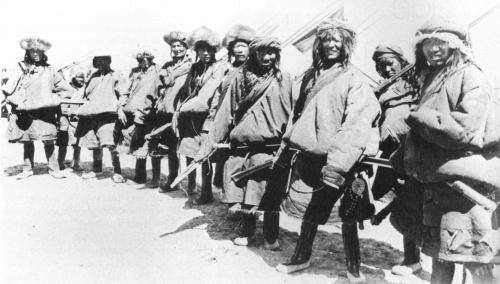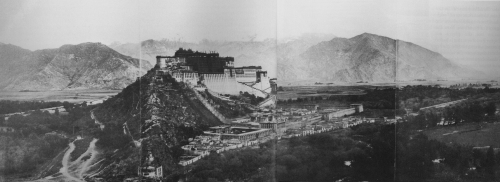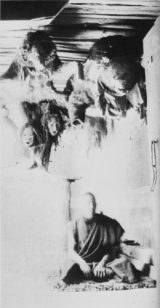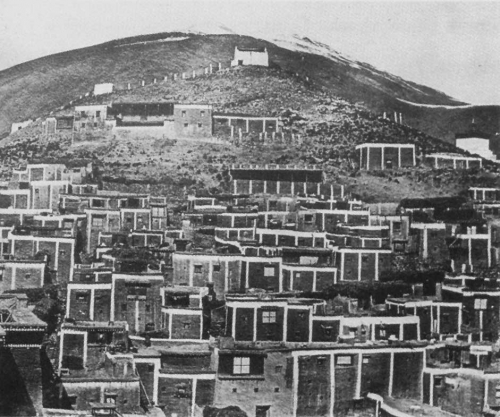Tibet and Tibetan Buddhism have long been objects of Western fantasy. From the time that Venetian travelers and Catholic missionaries encountered Tibetan monks at the Mongol court, tales of the mysteries of their mountain homeland and the magic of their strange—but also strangely familiar—religion have held a peculiar hold over the European and American imagination. Over the past two centuries, the valuation of Tibetan society and, particularly, its religion has fluctuated wildly. Tibetan Buddhism has been portrayed sometimes as the most corrupt deviation from the Buddha’s true dharma, sometimes as its most direct descendant. These fluctuations have occurred over the course of this century, as Tibet resisted the colonial ambitions of a European power at its beginning and succumbed to the colonial ambitions of an Asian power at its end.
The degradation of Tibetan Buddhism as corrupt—so corrupt, in fact, that it does not rightly deserve to be called Buddhism, but rather “Lamaism”—derives from at least two historical moments. The first occurred as early as 1253, when the Flemish Franciscan friar William of Rubrouck, visiting the Mongol court, wrote of the Tibetan monks: “Wherever they go, they also have constantly in their hands a string of a hundred or two hundred beads, like the rosaries we carry, and keep repeating On mani battam [sic], which means ‘God, you know.'” From that point on the apparent parallels between the outward forms of Catholic and Lamaist clerics were inevitably noted. And once noted, they had somehow to be explained. A theory of historical influence suggested that the legendary missionary of the twelfth century, Prester John, must have long ago introduced the true (Christian) faith to the Tibetans, who, in turn, kept the form but forgot the content. Another Catholic theory blamed the uncanny similarities on the devil. According to the old patristic notion of “demonic plagiarism,” Satan intentionally duplicates the forms of the Holy Church among the heathens in order to vex the faithful.
Tibetan Buddhism was scorned again during the Victorian period, when Buddhist studies were growing into an academic discipline. A rhetoric of the demonic came into play here as well, but for different reasons. With the discovery and translation of Sanskrit and Pali texts, the notion of “original Buddhism” came into prominence in the West. This Buddhism, portrayed as a “religion of reason” in Victorian Britain, was assumed to be long extinct, and it was this “original Buddhism” (sometimes called “true Buddhism”) that became the standard against which all the modern Buddhisms of Asia were judged—and inevitably found lacking. European and American philologists assumed the role of the true and legitimate conservators and heirs of a “classical tradition.” The Buddhists of Asia were judged to have deviated so far from the Buddha’s original message that they had forfeited all claims to it. Tibetan Buddhism was construed as the offspring, not of this religion of reason but of the Mahayana and Tantra, both seen as degenerations of the Indian textual tradition. In the words of L. Austine Waddell, amateur Tibetologist and chief sanitation officer for the Darjeeling district,
the Lamaist cults comprise much deep-rooted devil-worship. . . . For Lamaism is only thinly and imperfectly varnished over with Buddhist symbolism, bencath which the sinister growth of poly-demonist superstition darkly appears.
We see here a play of opposites: the pristine and the polluted, the authentic and the derivative, the holy and the demonic, the good and the bad. This opposition has operated throughout the history of Europe’s relation to Asia, “West” and “East,” or “Occident” and “Orient.” The play of opposites has been both extreme and volatile in the case of Tibet and continues to operate powerfully in contemporary attitudes toward Tibet and Tibetan Buddhism. Thus, “original Buddhism” was pure and authentic, while “Lamaism” was polluted and derived from the mixture of Buddhism and Bon, the “pre-Buddhist religion of Tibet.

But the opposition was also imagined to operate within Tibet. For many decades, what interested scholars about Tibet was not Tibetan literature or practice, but the translations of Sanskrit texts lost in India that were preserved in Tibet. These texts, even in translation, were valued as the authentic documents of Mahayana Buddhism, which had been condemned by an earlier generation of scholars as a deviation from the Buddha’s original teachings. Yet Tibetan commentaries on these works and their articulations in various ritual forms were generally dismissed as arid repetition devoid of the animation of authenticity. For example, the preeminent Tibetologist of this century, Giuseppe Tucci (1894-1984), wrote of the Tibetan Buddhism he observed on his travels, “Hardening of the arteries set in with the double threat of formulas replacing the mind’s independent striving after truth, and a withered theology taking the place of the yearning for spiritual rebirth.”
Even the more fanciful European interests in Tibet draw a distinction between the Tibetans’ own religious practice and the secret knowledge of occult masters. Thus the Theosophists believed Tibet to be the abode of the mahatmas, Atlantean masters who had congregated in a secret region of Tibet to escape the increasing levels of magnetism produced by civilization; yet the Theosophists also held that the location of this region remained unknown to the Tibetans. In James Hilton’s 1933 novel, Lost Horizon, what makes Shangri-la invaluable is not the presence of any indigenous knowledge but the fact that over the centuries, a Catholic missionary had gathered together all that was good in European culture—first editions of great books, priceless works of art, musical scores—to protect it from the impending world conflagration.
These nineteenth-century constructions of Tibetan Buddhism are part of the heritage of Orientalism, described by Edward Said as a European mode for gaining authority over the Orient, a mode whereby Orientals were controlled—politically and epistemologically—by scholars in Europe and colonial officials in Asia. An important part of this scholarship was the self-aggrandizing ability of European scholars to write histories of Oriental civilizations that identified their origins, their classical periods, and their decline. The last of these (also called “the modern period”) was marked by decay and impotence. The modern period was also contemporaneous with European colonialism, one of whose products for the West was knowledge about the East. According to the exponents of this new field of knowledge, the facts and artifacts of the classical period were rescued by the emergent Western scholarship from the custody of the Orientals, who failed to recognize them for what they were and hence lost any right to them. The Orientalist would henceforth speak for the Oriental through a lineage of scholarship whose task it was to represent the Orient because the Orient was incapable of representing itself. This representation of the East by the West carried with it the valuation of what was true and what was false, what was worthy and what was worthless. Furthermore, according to Edward Said’s Orientalism, the texts produced by European Orientalists had the power to “create not only knowledge but also the very reality they appear to describe” by essentializing and delimiting the object of knowledge. Said argues that Orientalism also had more direct political effects: its representations of the Orient provided a justification for imperialism and a foundation for colonial policies and institutions.
What is noteworthy about Tibet in the history of Orientalism is that, unlike most of the other Buddhist societies of Asia, Tibet neither came under direct European imperial control nor made any real attempt to “modernize” (despite certain failed attempts by the thirteenth Dalai Lama) by establishing European-style universities, importing European technologies, or sending elites for education in Europe. There are many reasons why the European powers were deterred, one of which is that in 1792, the Manchu emperor Qian-long declared imperial control over all Tibetan communications with foreign countries. This did not sever Tibet’s long-standing relations with Inner Asia and China. Instead, from that point until the twentieth century, further relations of Europeans with Tibet had to be positioned from the borderlands. In the nineteenth century, Tibet became a cherished prize in the Great Game played by the two great European powers of the region, Britain and Russia. Both made repeated attempts to establish relations with the government in Lhasa and often sent spies, sometimes disguised as Buddhist pilgrims, into Tibet on map-making missions. It was during this period that Tibet came to be consistently portrayed as “isolated” or “closed,” characterizations that meant little except in contrast to the case of China, which had been forcibly “opened” to British trade after the Opium War of 1839. Tibet was thus an object of imperial desire, and the failure of the European powers to dominate Tibet politically only increased European longing and added to the fantasy about life in the land beyond the Snowy Range. In the process, highly romanticized portrayals of traditional Tibet emerged, many of which continue to hold sway.

Many of these hyperrealities, ruled by the law of opposites, have come into play in the representation of the Chinese invasion and occupation of Tibet. There were times prior to the nineteenth century when India and China were exalted by the poets and philosophers of Europe. China had been a particular favorite of the French Enlightenment, which saw the rule of a huge population by a class of scholar-gentlemen, the mandarins, as an ideal. India was a favorite of the German Romantics, who saw it as an abode of Spirit. This was an early manifestation of the continuing Orientalist romance in which the “West” perceives some lack within itself and fantasizes that the answer, through a process of projection, is to be found somewhere in the “East.” But by 1800, when European colonial interests in Asia had accelerated, the popular valuation of both societies plummeted; they now seemed corrupt and backward, incapable of their own governance, such that their colonization was fully justified.
In the nineteenth century, both Tibet and China were regarded by many European scholars and colonial officers as “Oriental Despotisms,” one ruled by a Dalai Lama, an ethereal “god-king,” and the other by an effete emperor. During the Second World War, the Chinese, including the Communists, were briefly portrayed as a freedom-loving people, in contrast to the despotic Japanese. After the success of the Communists in 1949, the image of the oriental despot resurfaced and was easily transferred onto Chairman Mao, not as emperor but as the totalitarian leader of faceless Communists. What is notable is that the Chinese invasion and occupation of Tibet was not seen as the conquest of one despotic state by another but as yet another case of opposites, the powers of darkness against the power of light. The invasion of Tibet by the People’s Liberation Army in 1951 was represented (and in many cases, continues to be represented) as an undifferentiated mass of godless Communists overwhelming a peaceful land devoted only to ethereal pursuits, the victims of the invasion, including not only the hundreds of thousands of slaughtered Tibetans but the sometimes more lamented Buddhist dharma as well. Tibet is the embodiment of the powers of the holy; China is the embodiment of the powers of the demonic. Tibetans are superhuman, Chinese are subhuman. In this Orientalist logic of oppositions, China must be debased for Tibet to be exalted; for there to be a spiritual and enlightened Orient, there must be a demonic and despotic Orient.

With the Tibetan diaspora that began in 1959, Tibetan Buddhist culture has been represented as if it were itself another artifact of Shangri-la, as an entity existing outside of time and history, set in its own eternal classical age in a lofty Himalayan keep. With the Chinese takeover of Tibet, this timeless culture has been placed in profound jeopardy; it is as though we fear that exposure to time would cause the contents of that culture to wither and turn to dust, like the bodies of those who dare leave Shangri-la, as rendered so vividly in Frank Capra’s film of Lost Horizon. There is something apocalyptic about it, as if the Tibetans, long conservators of a timeless wisdom in a timeless realm, have been brutally thrust from their snowy sanctuary into history, where time is coming to an end and with it, their wisdom. In this particular version of the fantasy, those left in Tibet seem lost, while those in exile have to cope with the body blows of modernity, moving, as is often noted, from a country that even in the twentieth century had prayer-wheels but no wheels on wagons, multiple metaphoric vehicles to liberation but no carts.
How have Western scholars of Buddhism responded to this moment of historical crisis? In the 1960s and ’70s, the earlier Buddhological valuation of Tibetan Buddhism (still sometimes called Lamaism) as corrupt and derivative reached its antipodes, as young scholars came to exalt Tibet, just at the moment of its invasion and annexation by China, as a pristine preserve of authentic Buddhist doctrine and practice. Unlike the Buddhisms of China, Japan, and Southeast Asia, Tibetan Buddhism was now seen as uncorrupted because it had not been tainted by Western domination. The value of Tibet to scholars of Buddhism was no longer simply as an archive of the scriptures of Indian Buddhism, long lost in the original Sanskrit but held in highly accurate Tibetan translation. The Tibetan diaspora made widely available to the universities of Europe and North America (largely through the efforts of the Library of Congress office in New Delhi) a great flood of autochthonous Tibetan Buddhism literature, heretofore unstudied. This literature, scorned by L. Austine Waddell at the end of the last century as “contemptible mummery,” was now hailed by Orientalists of a new age, both professional and amateur, as a repository of ancient wisdom whose lineage, as the lamas claimed, could be traced back to the Buddha himself. In the Victorian period, the authentic texts of “original Buddhism” had been exalted above the superstitious practices of Buddhists. Now, the opposition remains, but the places are reversed. It is Tibetan Buddhism that is hailed as original and pristine, a living tradition rather than a dead text. And once again, the agency of the Tibetans is denied, as a new generation of Westerners take upon themselves the role of conservators of this living fossil.
Once again, the old dichotomy has been brought into play, as pre-1959 Tibet is contrasted with post-1959 Tibet. The ravages wrought by China’s policies in Tibet, resulting not only in the destruction of monasteries, temples, texts, and works of art, but in the death of hundreds of thousands of Tibetans, would seem to be enough to sustain the clear contrast with life in Tibet prior to the invasion. But here, once again, the logic of opposites is at work. In the popular imagination of the increasing number of Western adherents of Tibetan Buddhism, “traditional Tibet” has come to stand as something from which they derive strength and identity, representing what we someday can be, an ideal to which we can aspire, an ideal that once existed on the planet in high Tibet, a land free from strife ruled by a benevolent Dalai Lama, his people devoted to the dharma and (we have recently learned) the preservation of the environment. It is here that we see the volatility of the mythologizing and mystification of Tibetan culture. We often hear, for example, that Tibetan society was hermetic, sealed off from outside influence. Yet the reports of travelers from the early eighteenth century note Tartars, Chinese, Muscovites, Armenians, Kashmiris, and Nepalese established in Lhasa as merchants. The monasteries in Lhasa drew monks from as far away in the west as the Kalmuck region of the Soviet Union, located between the Caspian Sea and the Black Sea, from as far east as Sichuan province in China, from as far north as the Buryiat region near Lake Baikal in Siberia, and from as far south as the Sherpa regions of Nepal.

Nor was Tibet “an unarmed society,” in Georges Bataille’s phrase. Tibet did not renounce armed conflict when it converted to Buddhism in the eighth century, or in the eleventh century, or under the fifth Dalai Lama. The fifth Dalai Lama assumed temporal power over Tibet through the intervention of his Qoshot Mongol patron, the Gushri Khan, whose troops defeated the king of Tsang, patron of the Karma Kagyu (Karma bKa’ rgyud). Tibetan armies fought against Ladakh in 1681, against the Dzungar Mongols in 1720, in numerous interventions into Bhutan in the eighteenth century, against invading Nepali forces in 1788-92 and 1854, against Dogra forces invading Ladakh from Kashmir in 1842, and against the British in 1904.
Tibet, prior to the Chinese invasion and colonization, is presented as an ideal society devoted to the practice of Buddhism, a nation that required no police force because the people voluntarily observed the laws of karma, a society where a peasant boy could become a great lama through the workings of an “inner democracy.” But traditional Tibet, like any complex society, had great inequalities, with power monopolized by an elite composed of a small aristocracy, the hierarchs of various sects (including incarnate lamas), and the great Gelugpa (dGe lugs pa) monasteries. The subaltern members of the society included nonaristocratic laymen, non-Buddhists, and women. It is certainly the case that peasant boys could be and were chosen as Dalai Lamas and that nomad boys could pass through the monastic curriculum to become respected scholars and abbots. But it does not follow from this that the system of incarnation was some kind of cosmic meritocracy above a mundane world of power and politics. In Tibet, as everywhere else, there was the inevitable mingling of the hieratic and earthly powers. After the death of the third Dalai Lama, to whom the Mongol leader, the Altan Khan, had pledged his support, the Altan Khan’s great-grandson was recognized as the fourth Dalai Lama. Indeed, the spread of Tibetan Buddhism can usefully be traced by the increasingly large geographical areas in which incarnate lamas are discovered, extending today to Europe and North America.
The most recent myth to gain currency is that Tibet was a kind of ecological paradise where animals ran free without fearing the hunter and where mining was prohibited so as not to disturb the earth spirits. But Tibetans did and do hunt for food and fur and musk, and have mined for things such as gold, iron ore, and borax since before the time of the fifteenth-century Buddhist yogi and builder of iron bridges, Thang stong rgyal po.

But the point is not to provide a catalogue of facts in order to debunk our most cherished fantasies about Tibet (as useful as such a project might be), toward a more accurate representation or a clearer image of what Tibet was or is “really like.” Such an agenda carries with it its own ideology of control, one which was put to devastating use during the colonial period. Nor is the point to suggest that Tibetan Buddhism was merely an oppressive system exercised in bad faith by power-hungry clerics. The more important question is why these myths persist, continuing to circulate unchallenged. These fantasies of Tibet operate as constituents of a Romantic Orientalism in which the Orient is not debased but exalted as a surrogate self endowed with all that the West lacks. It is Tibet that will regenerate the West by showing us, prophetically, what it can be by showing us what it has been. It is Tibet that can save the West, cynical and materialist, from itself. An internal absence is thus perceived as existing outside, and if it be outside, let it be found in the most remote, the most inaccessible, the most mysterious part of the world. Tibet is seen as the cure for an ever-dissolving Western civilization, restoring its spirit. And since the Tibetan diaspora that began in 1959, there seems an especial urgency about receiving that cure, before it is lost forever. This New Age Orientalism is no doubt bolstered by certain Buddhist notions of the decline of the dharma and of the rarity of human rebirth. But the fantasy of Tibet is our fantasy, as the relentless logic of opposites continues to operate, most recently as Western Buddhists strive to draw a dividing line between those elements of the Tibetan Buddhist tradition that are “true,” in the sense that they can be transferred unchanged to the West, and those which are “cultural,” the products of historical conditions and hence dispensable.
Fantasies of Tibet have in the past three decades inspired much support for the cause of Tibetan independence. But those fantasies are ultimately a threat to the realization of that goal. It is not simply that learning that Tibet was not the place we dreamed it to be might result in some “disillusionment.” It is rather that to allow Tibet to circulate as a constituent in a system of fantastic oppositions (even when Tibetans are the “good” Orientals) is to deny Tibet its history, to exclude Tibet from a real world of which it has always been a part, and to deny Tibetans their role as agents participating in the creation of a contested quotidian reality. To the extent that we continue to believe that Tibet prior to 1950 was a utopia, the Tibet of 1994 will be no place.